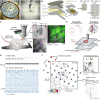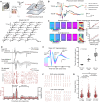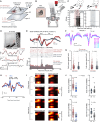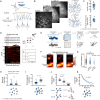Touch-evoked traveling waves establish a translaminar spacetime code
- PMID: 39889002
- PMCID: PMC11784861
- DOI: 10.1126/sciadv.adr4038
Touch-evoked traveling waves establish a translaminar spacetime code
Abstract
Linking sensory-evoked traveling waves to underlying circuit patterns is critical to understanding the neural basis of sensory perception. To form this link, we performed simultaneous electrophysiology and two-photon calcium imaging through transparent NeuroGrids and mapped touch-evoked traveling waves and underlying microcircuit dynamics. In awake mice, both passive and active whisker touch elicited traveling waves within and across barrels, with a fast early component followed by a late wave that lasted hundreds of milliseconds poststimulus. Notably, late waves were modulated by perceived value and predicted behavioral choice in a two-whisker discrimination task. We found that the late wave feature was (i) modulated by motor feedback, (ii) differentially engaged a sparse ensemble reactivation pattern across layer 2/3, which a balanced-state network model reconciled via feedback-induced inhibitory stabilization, and (iii) aligned to regenerative layer 5 apical dendritic Ca2+ events. Our results reveal that translaminar spacetime patterns organized by cortical feedback support sparse touch-evoked traveling waves.
Figures







Update of
-
A Translaminar Spacetime Code Supports Touch-Evoked Traveling Waves.bioRxiv [Preprint]. 2024 May 9:2024.05.09.593381. doi: 10.1101/2024.05.09.593381. bioRxiv. 2024. Update in: Sci Adv. 2025 Jan 31;11(5):eadr4038. doi: 10.1126/sciadv.adr4038. PMID: 38766232 Free PMC article. Updated. Preprint.
Similar articles
-
A Translaminar Spacetime Code Supports Touch-Evoked Traveling Waves.bioRxiv [Preprint]. 2024 May 9:2024.05.09.593381. doi: 10.1101/2024.05.09.593381. bioRxiv. 2024. Update in: Sci Adv. 2025 Jan 31;11(5):eadr4038. doi: 10.1126/sciadv.adr4038. PMID: 38766232 Free PMC article. Updated. Preprint.
-
Temporal Sharpening of Sensory Responses by Layer V in the Mouse Primary Somatosensory Cortex.Curr Biol. 2020 May 4;30(9):1589-1599.e10. doi: 10.1016/j.cub.2020.02.004. Epub 2020 Mar 12. Curr Biol. 2020. PMID: 32169206 Free PMC article.
-
A Non-canonical Feedback Circuit for Rapid Interactions between Somatosensory Cortices.Cell Rep. 2018 May 29;23(9):2718-2731.e6. doi: 10.1016/j.celrep.2018.04.115. Cell Rep. 2018. PMID: 29847801 Free PMC article.
-
Neocortical dynamics during whisker-based sensory discrimination in head-restrained mice.Neuroscience. 2018 Jan 1;368:57-69. doi: 10.1016/j.neuroscience.2017.09.003. Epub 2017 Sep 14. Neuroscience. 2018. PMID: 28919043 Free PMC article. Review.
-
Texture coding in the whisker system.Curr Opin Neurobiol. 2010 Jun;20(3):313-8. doi: 10.1016/j.conb.2010.02.014. Epub 2010 Mar 17. Curr Opin Neurobiol. 2010. PMID: 20299205 Review.
Cited by
-
Advances in Neuroimaging and Deep Learning for Emotion Detection: A Systematic Review of Cognitive Neuroscience and Algorithmic Innovations.Diagnostics (Basel). 2025 Feb 13;15(4):456. doi: 10.3390/diagnostics15040456. Diagnostics (Basel). 2025. PMID: 40002607 Free PMC article. Review.
References
MeSH terms
Substances
Grants and funding
LinkOut - more resources
Full Text Sources
Miscellaneous

